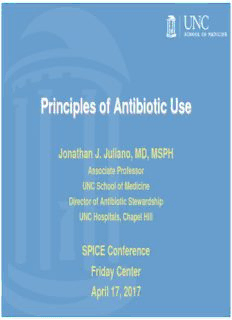
Principles of Antibiotic Use PDF
Preview Principles of Antibiotic Use
Principles of Antibiotic Use Jonathan J. Juliano, MD, MSPH Associate Professor UNC School of Medicine Director of Antibiotic Stewardship UNC Hospitals, Chapel Hill SPICE Conference Friday Center April 17, 2017 Conflicts of Interest • None 4/19/2017 2 Goals of Lecture • Current anti-infectives » Antibiotic development » Mechanisms of action • Practical classification of microbes for choosing an antibiotic » Diagnosis » Choosing an appropriate antibiotic therapy • Antimicrobial Resistance » Factors impacting development and spread of resistance » Mechanisms of Resistance » Methods for Testing Resistance • Antibacterial Stewardship TRENDS IN ANTIMICROBIAL DEVELOPMENT • Fewer companies producing antibiotics and few antibiotics introduced TRENDS IN ANTIMICROBIAL DEVELOPMENT • Therapy directed at emerging drug resistance • Broader spectrum • Reduced dosing frequency • Novel mechanisms of action and coverage • Modifications based on understanding structure- function relation • Newly introduced agents focused on coverage of resistant S. aureus and Enterococcus, HIV, and fungi (especially uncommon Candida spp. and zygomycetes) CAVEATS IN EVALUATING NEW DRUGS • Most studies powered to demonstrate equivalence • Studies rarely (if ever) compare newer agents head to head (e.g., daptomycin versus linezolid, voriconazole versus caspofungin) • Phase III study sizes preclude demonstrating rare side effects • Phase III studies conducted in highly selected populations » May not uncover drug interactions » Will not demonstrate safety in all patient populations • American Academy of Pediatrics • American Gastroenterology Association • Trust for America’s Health • Society for Healthcare Epidemiology of America • Pediatric Infectious Disease Society • Michigan Antibiotic Resistance Reduction Coalition • National Foundation for Infectious Diseases • European Society of Clinical Microbiology and Infectious Diseases Support the development of 10 new systemic antibacterial drugs through the discovery of new drug classes as well as exploring possible new drugs from existing classes of antibiotics. Support the concurrent advancement of improved diagnostic tests specific to multidrug-resistant infections CID (2010) 50: 8, pp 1081-1083. Goals Goal 1: Slow the Development of Resistant Bacteria and Prevent the Spread of Resistant Infections Goal 2: Strengthen National One-Health Surveillance Efforts to Combat Resistance Goal 3: Advance Development and Use of Rapid and Innovative Diagnostic Tests for Identification and Characterization of Resistant Bacteria Goal 4: Accelerate Basic and Applied Research and Development for New Antibiotics, Other Therapeutics and Vaccines Goal 5: Improve International Collaboration and Capacities for Antibiotic Resistance Prevention, Surveillance, Control and Antibiotic Research and Development Antibiotics Approved Since 2010 2010 2011 2012 2013 2014 2015 Ceftaroline Telavancin* Tedizolid Ceftazidime Dalbavancin Avibactam Oritavancin Ceftolozane Tazobactam Mechanisms of Action of Antibiotics Metronidazole – Fluoroquinolones Cell wall β-lactams synthesis Cephalosporins – Carbapenems Sulfonamides TMP-SMX – DNA replication Topo- – Protein isomerase mRNA Nucleotide biosynthesis Protein synthesis RNA transcription – mRNA – GGllyyccyyllccyycclilnineess – Cytoplasmic Peptide Aminoglycosides membrane Rifampin antibiotics Macrolides integrity Oxazolidinones Streptogramins TMP-SMX = trimethoprim-sulfamethoxazole. Lincosamides Tetracyclines Adapted from: Chopra I. CurrOpinPharmacol. 2001;1:464-469. 10
Description: